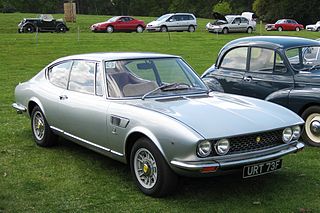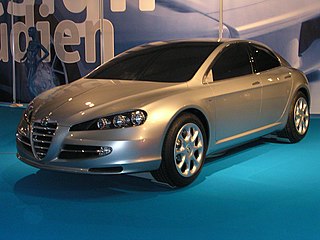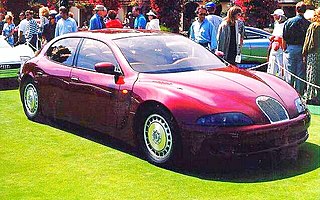
The Aston Martin DB7 is a car which was produced by British luxury car manufacturer Aston Martin from September 1994 to December 2004. It was designed by Ian Callum and Keith Helfet as a grand tourer in coupé and convertible bodystyles. The prototype was complete by November 1992 and debuted at the Geneva Motor Show in March 1993. The six-cylinder DB7 was positioned as an "entry-level" model below the hand-built V8 Virage introduced a few years earlier. This model was the most-produced Aston Martin automobile up to that point in time, with more than 7,000 built before it was replaced by the DB9 in 2004.

The Ferrari 612 Scaglietti is an executive 2+2 coupé grand tourer manufactured by Italian automobile manufacturer Ferrari between 2004 and 2010. It was designed to replace the smaller 456; its larger size makes it a true 4 seater with adequate space in the rear seats for adults.

The Fiat Dino was a front-engine, rear-wheel-drive sports car produced by Fiat from 1966 to 1973. The Dino name refers to the Ferrari Dino V6 engine, produced by Fiat and installed in the cars to achieve the production numbers sufficient for Ferrari to homologate the engine for Formula 2 racing.

The BMW E32 is the second generation of the BMW 7 Series luxury cars and was produced from 1986 until 1994. It replaced the E23 and was initially available with straight-six or V12 powerplants. In 1992, V8 engines became available. From its inception, the E32 was among the most technologically advanced series of cars in its day.

The Isuzu Piazza is a small, sporty 3-door liftback coupé which was manufactured by Isuzu from 1981 until 1992 in two generations. The Isuzu Piazza was marketed as the Isuzu Impulse in North America and as the Holden Piazza in Australia.

BMW M GmbH, formerly known as BMW Motorsport GmbH, is a subsidiary of BMW AG that manufactures performance cars.

The BMW M1 is a mid-engined sports car produced by German automotive manufacturer BMW from 1978 until 1981.

The Alfa Romeo Brera and the Alfa Romeo Spider are mid-size sports cars using the GM/Fiat Premium platform, manufactured by Pininfarina and marketed by Alfa Romeo as a 2+2 coupé and roadster respectively.

Alpina Burkard Bovensiepen GmbH & Co. KG is an automobile manufacturing company based in Buchloe, in the Ostallgäu district of Bavaria, Germany that develops and sells high-performance versions of BMW cars. Alpina works closely with BMW and their processes are integrated into BMW's production lines, and is recognized by the German Ministry of Transport as an automobile manufacturer, in contrast to other performance specialists, which are aftermarket tuners. The Alpina B7 is produced at the same assembly line in Dingolfing, Germany, as BMW's own 7 Series. The B7's twin-turbo 4.4-litre V8 is assembled by hand at Alpina's facility in Buchloe, Germany, before being shipped to BMW for installation, and the assembled vehicle is then sent back to Alpina for finishing touches.

The Alfa Romeo 2000 is a luxury car produced by Italian car manufacturer Alfa Romeo between 1958 and 1962, as a successor to the 1900 Super. It was replaced in 1962 by the Alfa Romeo 2600.

The Alfa Romeo 33 Stradale is a mid-engine sports car built by Italian automobile manufacturer Alfa Romeo. It was the fastest commercially available car for the standing kilometer upon its introduction. 18 examples were produced between 1967 and 1969. "Stradale" is a term often used by Italian car manufacturers to indicate a street-legal version of a racing car; indeed the 33 Stradale was derived from the Tipo 33 sports prototype. Built in an attempt by Alfa Romeo to make some of its racing technology available to the public, it was also the most expensive automobile for sale to the public in 1968 at US$17,000.

The Alfa Romeo Scighera is a functional, futuristically styled concept car designed by Fabrizio Giugiaro and manufactured by Italdesign of Turin, Italy in 1997 for automobile manufacturer Alfa Romeo. The name "Scighera" means mist in the Milanese dialect.

The Bugatti 18/3 Chiron is a 1999 concept car developed by French automobile manufacturer Bugatti Automobiles and designed by Fabrizio Giugiaro of Italdesign. Powered by a 6.3 L W18 engine, it is a 2-seater mid-engine coupé. The 18/3 Chiron was the last in a trio of Bugatti concept cars by Italdesign, after the 1998 EB 118 coupé and the 1999 EB 218 saloon.

The Alfa Romeo Visconti is a concept car made by the Italian car manufacturer Alfa Romeo, designed by Giorgetto Giugiaro. The car was seen for the first time at the Geneva Motor Show in 2004. The car is a four-door fastback coupé/sedan and is almost 5 metres (200 in) long. Under the bonnet is a 3.2-litre V6 JTS biturbo engine, which produces 405 PS at 6000 rpm and 680 N⋅m (502 lbf⋅ft) of torque at 2000 rpm.

The BMW E31 is the first generation of the BMW 8 Series. It is a grand tourer built by BMW from 1990 to 1999 as a 2-door coupé, powered by either a V8 or V12 engine. Whilst it did supplant the original E24 based 6 Series in 1990, it was not a direct successor, but a new model class with a substantially higher price and performance than the 6 Series.

The Bugatti EB 112 is a concept 4-door fastback saloon presented by Bugatti Automobili S.p.A. in 1993. Giorgetto Giugiaro of Italdesign was responsible for designing the car. The EB 112 features a 456 PS V12 engine and permanent four-wheel drive system.

The Alpina B6 (E63) is the second generation of the high performance grand tourer manufactured by German automobile manufacturer Alpina from 2005 to 2010. Based on the BMW 6 Series (E63), the car was available in coupé and convertible bodystyles. The B6 was introduced in 2005.

The Alpina B6 (F12) is the third generation of the high performance grand tourer manufactured by German automobile manufacturer Alpina. Introduced at the 2011 Tokyo Motor Show, the B6 was based on the BMW 6 Series and was available in coupé and convertible body styles, with the latter being introduced at the 2011 Frankfurt Motor Show. A third saloon bodystyle called the gran coupé was introduced in 2014. The Alpina B6 gran coupé was replaced by the Alpina B8 gran coupe (G16) in 2021.
The Ford Maya is a concept car designed and built by Italdesign for Ford. It debuted in 1984 at the Turin Motor Show.

The Alpina B12 is a name given to high-performance luxury automobiles manufactured by German automobile manufacturer Alpina. The B12 originally succeeded the B11 4.0 in 1988 which was based on the BMW 7 Series (E32) and was also based on the same car. Subsequent models were based on the BMW 7 Series (E38) and the BMW 8 Series (E31). Production ended in 2001 when the 7 Series (E38) models were discontinued. The B12 was replaced by the B7 (E65) and the B6 (E63).





















